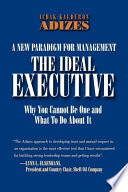

The ideal executive recognizes that they cannot succeed alone and must build a strong team to support their vision. The book discusses the importance of hiring the right people, developing their skills, and fostering a culture of collaboration. The author highlights the need for executives to empower their teams, providing them with the autonomy to make decisions and take ownership of their work. This not only enhances productivity but also boosts morale and job satisfaction. Furthermore, the book explores the dynamics of team leadership, emphasizing that an effective executive must be able to motivate and inspire their team towards a common goal.
Continue readingThe book emphasizes that the primary role of an executive is to make decisions that affect the organization as a whole. This involves not just operational decisions, but strategic ones that can set the direction for the future of the company. The author argues that executives must focus on the broader vision and mission of the organization, rather than getting bogged down in day-to-day operations. This means prioritizing long-term goals and ensuring that every decision aligns with the overarching objectives of the organization. The ideal executive is one who can balance immediate needs with future aspirations, ensuring that the company remains agile and responsive to changes in the market.
Continue readingCommunication is a critical skill for any executive. The author stresses that the ideal executive must be able to convey their vision and decisions clearly to their teams and stakeholders. This involves not only speaking effectively but also listening to feedback and fostering an environment where open communication is encouraged. The book discusses the importance of transparency and honesty in communication, as these traits build trust within the organization. Executives must also be adept at tailoring their messages to different audiences, ensuring that everyone understands their role in achieving the company's goals.
Continue readingThe book introduces various frameworks that executives can use to make informed decisions. These frameworks help in analyzing situations, weighing options, and considering the potential impact of decisions on the organization. The author emphasizes the importance of data-driven decision-making, encouraging executives to utilize available information to guide their choices. Additionally, the book discusses the need for flexibility in decision-making, as circumstances can change rapidly in the business world. The ideal executive is one who can adapt their approach based on the evolving landscape while still adhering to the company’s core values.
Continue readingStrategic thinking is a cornerstone of effective executive leadership. The book argues that the ideal executive must be able to anticipate future trends and challenges, positioning their organization to capitalize on opportunities. This involves conducting thorough market analysis, understanding competitive dynamics, and recognizing emerging technologies that could disrupt the industry. The author encourages executives to cultivate a forward-thinking mindset, enabling them to not only react to changes but also proactively shape the future of their organization. The emphasis is on long-term planning and the ability to pivot strategies as necessary.
Continue readingEthical leadership is a recurring theme in the book. The author posits that the ideal executive must uphold strong ethical standards, ensuring that their decisions reflect the values of the organization. This involves making tough choices that may not always align with short-term profits but are in the best interest of stakeholders in the long run. The book discusses the importance of corporate social responsibility and how ethical practices can enhance a company’s reputation and build customer loyalty. Executives are urged to lead by example, fostering a culture of integrity and accountability within their organizations.
Continue readingThe business landscape is constantly evolving, and the ideal executive must embrace continuous learning and adaptation. The book emphasizes the need for executives to stay informed about industry trends, technological advancements, and changing consumer preferences. This involves investing in professional development, attending conferences, and networking with other leaders. The author encourages executives to cultivate a culture of learning within their organizations, where innovation is celebrated, and employees are encouraged to pursue new ideas. The ability to adapt to change is presented as a critical skill for long-term success.
Continue reading